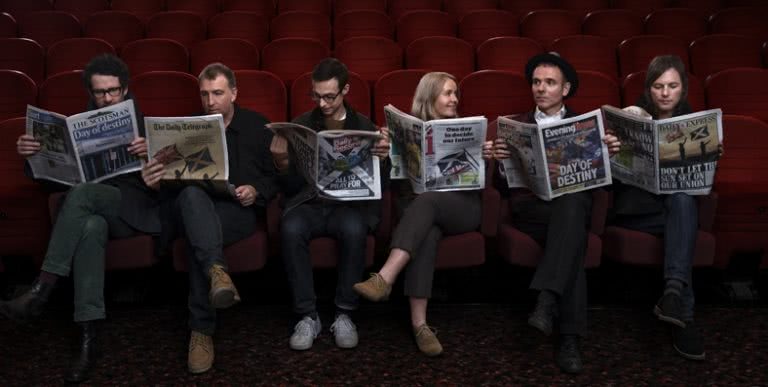Belle and Sebastian command a particularly loyal following. Between the strength of their lyrics and the group’s overall aesthetic, their listeners are drawn from a wide pool. With the electronic shift of new albumGirls In Peacetime Want To Dance, they are well placed to gain a whole new sweep of fans again.
It’s a pleasantly unsurprising leap for a band that has long been a favourite of music mavens but has yet to strike that commercial vein; from the beginning, Belle and Sebastian have been reluctant to be categorised. Drummer Richard Colburn recalls their early days of fake biographies and shifting sounds.
“We definitely fictionalised quite a lot!” he chuckles. It is cold and rainy here in Sydney, but Colburn wins the weather game; down the phone line I hear a Glasgow snowstorm wailing, and gale force winds are battering the walls. “Another thing we did was to take band photographs, but just get a bunch of friends along to be in them. I think the first time there was ever a real band photograph, it was me lying underneath a van like I’d just been knocked over. It was all a little obscure, but we just didn’t want to have a press angle in the beginning. We wanted the music to be the focus. I remember we had a few interviews with big magazines and they’d bring along a photographer, and we’d go, ‘No, no, we want to do our own photographs.’ And of course that would always turn out ridiculously. Those early years were very anti-press.”
I hazard that after so many years of touring and recording, Colburn’s appreciation for the press has become slightly more pronounced. After all, the last thing this interview needs is a pissed-off Glaswegian drummer in a snowstorm feeding disinformation to a gullible Australian journo. That said…
“I’m not too bad. Over the last three records we’ve done a lot more press than ever before. Sometimes it can be annoying in that once you start some media campaign, a lot of journalists will just jump on that first interview and take all the quotes, pull it to bits and throw it back at you. Now we have someone who handles all of it, so that the interviews we do do are big ones, the interesting ones that are going to get the best spread. It’s just one of those things in this modern age as well, you kind of have to just do it. And with bloggers, reviewers everywhere, whatever you do, it’s going to be catalogued somewhere.”
He sounds resigned to the role, but happily so. The band is now just a few years shy of its 20th anniversary, and whatever highs and lows the life of a musician can offer, Colburn is by now surely familiar with them. Belle and Sebastian’s sound has evolved steadily over this time, thanks in part to a host of creative producers enlisted along the way, but also by that old chestnut of practice makes perfect. From 2006’s The Life Pursuit on, Colburn’s drumming in particular has become much more prominent.
“In the early days, Stuart [Murdoch] sang so quietly and so far away from the microphone that if we’d try to play even slightly louder it would spill into his mic and you’d get nothing but feedback. Especially when we were playing live. So for the first couple of records I just played brushes or plastics, and if I ever tried drumsticks I had to do it really, really lightly because they’d interfere with his vocals. And that’s just the way it was. It was good training for me, but as Stuart got more confident singing…” Colburn trails off for a moment, trying to summon the memory. “It might have been 2001 when we started to tour properly. Before that we were quite sporadic and the shows weren’t quite clear. So as we toured more, we grew confident and played better, and I could start fitting in a little more since everyone else had started playing stronger as well. Especially Stuart’s singing. After that, a lot of songs definitely needed a heavy backbeat or a stronger rhythm, and after a while we got used to it. But those early days, brushes all the way. I’d never break a sweat,” he laughs.
Preparing the new record came with the double-edged sword of a larger budget and production than previous outings. It allowed for more flexibility in the studio and more elaborate live sets, but had the potential to add a level of expectation and self-consciousness the band could well do without.
“With a bigger budget you generally get more time, or at least more facilities, different producers,” says Colburn. “From that side of things it opens up more possibilities. But at the same time, it does put pressure on you, because now you have to come up with something that’s actually good!” he laughs.
“I feel in this day and age the album is slowly coming back, but the way people listen to music now, people listen to songs individually. It’s not like years ago where the album ruled. We’ve always been a fan of one body of work, and that’s the album. And that needs to flow perfectly, each part has to be right. We still look at albums as albums. They should never be just a vehicle for individual songs.”
Girls In Peacetime Want To Dance out Friday January 16 through Matador/Remote Control. Catch them atEnmore Theatreon Thursday January 29 (tickets here) andTaronga Zoo onSaturday January 31 (tickets here).

































